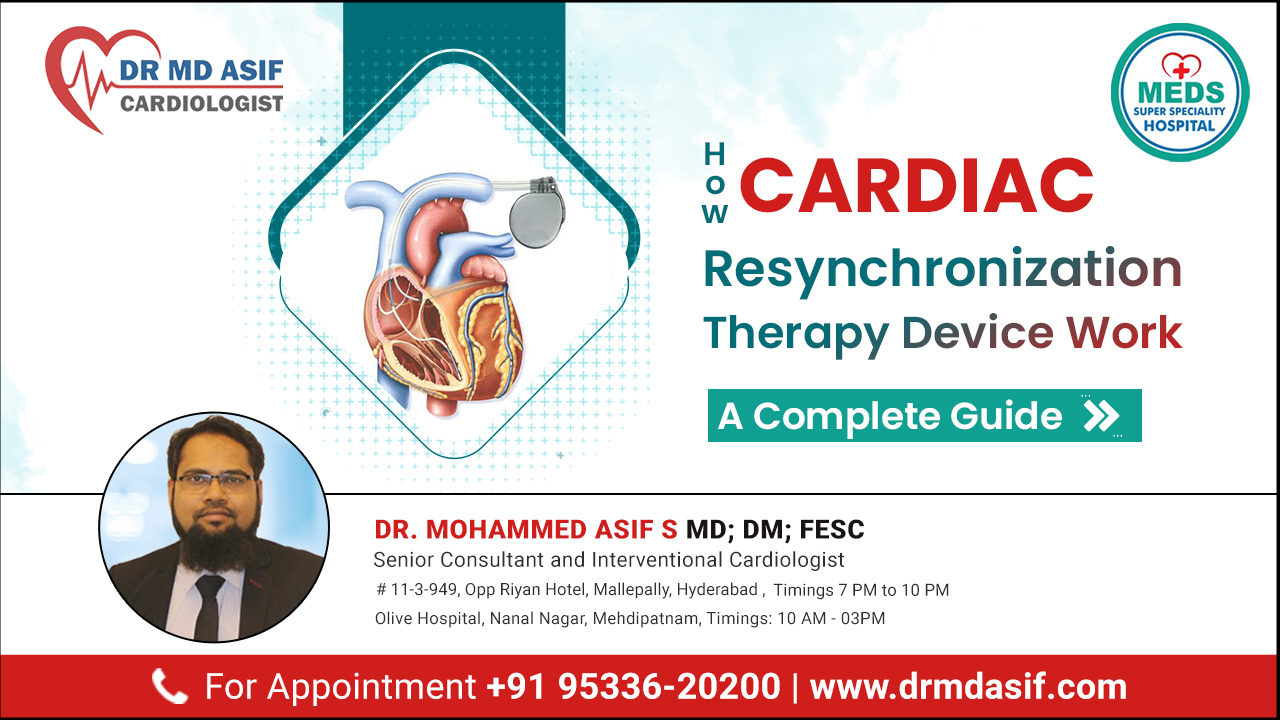Call us for any question
9533620200, 8179002888Meds Super Speciality Hospital
MallepallyTimings: 7 pm to 10 pm
mohammed4248asif@gmail.com

Blog s
How Cardiac Resynchronization Therapy Device Work: A Complete Guide

Updated at: 23 May 2023
Introduction
Improve your hearts condition with Cardiac Resynchronization Therapy (CRT) devices. That not only enhances your hearts beating function but also monitors your progress. Also, it helps doctors make the right decision for your treatment. This procedure involves planting a device in the chest that promotes an organized and effective way of pumping. Learn more about how this device can work for you below.
Improve Your Hearts Functionality: Understanding Cardiac Resynchronization Therapy
If you suffer from heart failure, it can be a daily struggle to pump enough blood to maintain basic bodily functions. But with the latest treatment, cardiac resynchronization therapy, you no longer have to feel limited. This procedure helps treat heart failure by synchronizing the lower chambers of your heart, which are responsible for most of the pumping. By reducing the symptoms of heart failure, this therapy can minimize the associated risks and ultimately make you feel better. Also, it prevents many complications, such as death.
What is CRT Device?
A CRT device is a combination of a two-part system.
Such as a pulse generator and a thin, insulated wires which called as leads. By delivering minuscule amounts of electrical energy to the heart, the CRT Device actively restores the normal timing of the heartbeats. As a result, both ventricles pump together more efficiently, resembling a normally closing fist.
Discovering the Two CRT Varieties
In the current medical science, there are two unique types of CRT devices available. One of them is a particular variety of CRT pacemakers known as a cardiac resynchronization therapy pacemaker (CRT-P) or biventricular pacemaker. The other is referred to as a cardiac resynchronization therapy defibrillator (CRT-D), and it has an integrated implantable cardioverter defibrillator (ICD).
Read more : Pacemaker Surgery and Its Types
How Cardiac Resynchronization Therapy Pacemaker (CRT-P) Device Work?
Your heart can pump more efficiently with a cardiac resynchronization therapy pacemaker (CRT-P) device. In addition to treating slow heart rhythms, it also sends electrical impulses to both ventricles to help them contract at the same time. Think of it as a boost for your ticker.
How Cardiac Resynchronization Therapy Devices Work?
CRT devices can be a great solution for those at high risk of sudden cardiac death. It acts like a pacemaker. The device sends small electrical impulses to the hearts ventricles to promote proper contraction. The result? A more efficient and effective heartbeat.
But there is more. The CRT device also addresses arrhythmias or dangerously fast heart rhythms. In these cases, the device delivers a life-saving shock to the heart, stopping the irregular rhythm and preventing sudden cardiac arrest. Without this swift intervention, life can lead to death.
Your CRT Device Battery
Your CRT devices battery life depends on the doctor-programmed settings and therapy amount. Unfortunately, the battery is permanently sealed inside the device and cannot be replaced once depleted. That means a full device replacement is necessary if the battery runs out. Your device will regularly check the batterys energy level and alert your doctor if it needs replacing. To prevent complications, your doctor can also turn on an alert feature that beeps when the replacement time is near. If you hear the beep, contact your doctor immediately.
Understand the Risks of Cardiac Resynchronization Therapy with CRT-D Implantation
The most common complications include infection, bleeding, collapsed lung, and cardiac tamponade caused by fluid buildup around the heart. Failure of the device, shifting of device parts, heart attack, and stroke are also potential risks to consider. Be prepared and informed before making any decision about CRT with a CRT-D implant.
Experience the Process of Cardiac Resynchronization Therapy: A Minor Surgery
Cardiac resynchronization therapy involves a minor surgical procedure inserting a chest device. You will be awake during the process but will receive medication to ensure relaxation. The area where the pacemaker is inserted will be numbed, and the entire surgery typically takes just a few hours.
Throughout the surgery procedure, insulated wires are placed into a significant vein under or close to the collarbone and directed to the heart using X-ray pictures. One end of each cable is connected to the location on the heart to which it belongs. The second is linked with a pulse generator that is often inserted beneath the skin of the collarbone at the same time.
Conclusion
Cardiac Resynchronization Therapy is a great help for those suffering from heart conditions. It is important to have an experienced healthcare specialist properly assess your current health and understand what the CRT-D device might do before any decisions need to be made regarding implantation. If you or someone close to you feel this device might provide assistance, please visit Drmdasif today or call us at +91 9533620200 to learn more about CRTD implant procedure in Hyderabad and our other services. With the right professional help, you can get the best treatment plan with us.
Comments

Be the first to Comment
Latest Post
-
⇨10 ways to control high blood pressure without medication
-
⇨Know the Dos and Donts after heart bypass surgery
-
⇨Angioplasty vs CABG : All You Need to Know
-
⇨A Closer Look at Angiography Risks and Benefits
-
⇨What is the difference between angioplasty and angiogram?
-
⇨Connections Between Depression and Heart Disease: What You Need to Know
-
⇨Finding the Best Cardiologist in Hyderabad: Tips and Tricks
-
⇨How to Recognize the Signs of a Heart Attack or Heartburn
-
⇨Why Are Permanent Pacemakers Necessary, and what to expect during surgery?
-
⇨The Impact of Patent Ductus Arteriosus on Quality of Life| Dr Asif
-
⇨What Are the Causes, Risk Factors, and Treatments of Ventricular septal defect?
-
⇨Exploring the Pacemaker Surgery Cost in Hyderabad: What You Need to Know.
-
⇨Discovering the Different Types of ASD: What You Need to Know
-
⇨The TAVR Surgery Cost in Hyderabad: A Comprehensive Guide| Dr. Asif
-
⇨Exploring the Advantages of TAVR: What You Should Know
-
⇨Visualizing Heart Health: An In-Depth Look at Coronary Angiogram
-
⇨Unlocking the Potential of Angioplasty: Types, Procedure Steps, and Promoting Speedy Recovery
-
⇨How Cardiac Resynchronization Therapy Device Work: A Complete Guide
-
⇨AICD Implantation in Hyderabad: A Comprehensive Guide for Heart Patients
-
⇨Pacemaker Surgery and Its Types: A Comprehensive Overview




Leave a reply